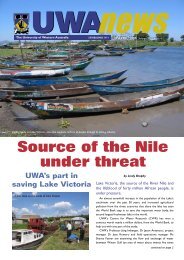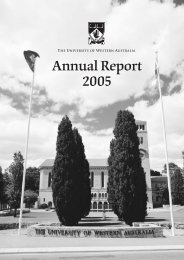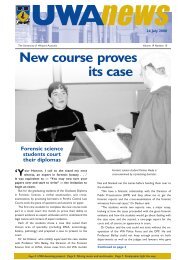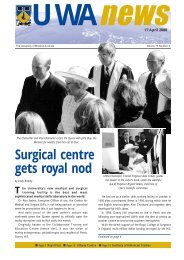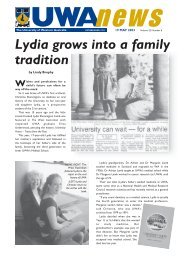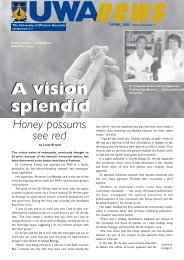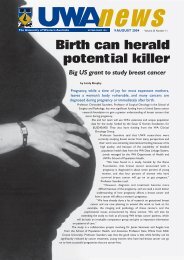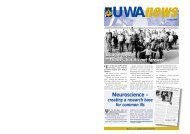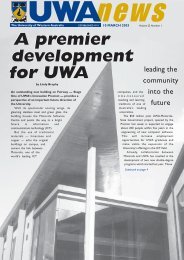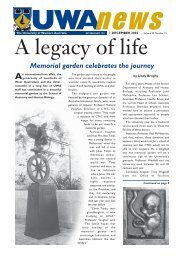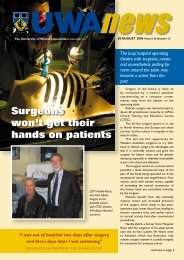22 Aug: Vol 24, #12 - UWA News staff magazine - The University of ...
22 Aug: Vol 24, #12 - UWA News staff magazine - The University of ...
22 Aug: Vol 24, #12 - UWA News staff magazine - The University of ...
- No tags were found...
Create successful ePaper yourself
Turn your PDF publications into a flip-book with our unique Google optimized e-Paper software.
Vice-Chancellor’scolumnTrackingprogress on theAcademic Pr<strong>of</strong>ileOur Academic Pr<strong>of</strong>ile wasdeveloped in 2000 as an integralpart <strong>of</strong> the <strong>University</strong>’s planningprocess.It was designed to provide the academicbasis for developing (and directingresources preferentially towards) areas<strong>of</strong> particular strength, importance andopportunity over a 10 year period.It set out a strategy for combininga greater emphasis on the selectivedevelopment and resourcing <strong>of</strong> particularactivities within the <strong>University</strong>, withinthe overall context <strong>of</strong> a comprehensiveteaching and research mission.This week, I provided to Senate amid-term (2005) assessment <strong>of</strong> progresstowards achieving the Academic Pr<strong>of</strong>ilewhich particularly highlighted two keyareas.<strong>The</strong> first relates to enrolment targets.Our Academic Pr<strong>of</strong>ile set an enrolmentgrowth target <strong>of</strong> between 20-25 per centover 10 years – with targets (by 2010) <strong>of</strong>a total enrolment <strong>of</strong> around 20,000; anundergraduate : postgraduate mix <strong>of</strong> 70:30;and within the 30 percent <strong>of</strong> postgraduates,a mix <strong>of</strong> 18 per cent research and 12 percent coursework. This year, we have atotal enrolment <strong>of</strong> 16,987, with 76.6 percent undergraduate, 10.4 per cent higherdegree by research, and 13.0 per centpostgraduate coursework.Set against a growth rate <strong>of</strong> 12 percentsince 2001, we can conclude that ourgrowth target <strong>of</strong> 20,000 by 2010 will bemet. However, while we are likely to farexceed the 12 per cent higher degree bycoursework target, unless we continue toact to ensure we increase higher degree byresearch enrolments, we will not achieveour higher degree by research target.We have already intervened to increasethe number <strong>of</strong> higher degree by researchenrolments as a result <strong>of</strong> a review <strong>of</strong>post-graduate research. Initiatives includeincreasing the number <strong>of</strong> <strong>University</strong> fundedscholarships, establishing a fund to meetthe cost <strong>of</strong> fees <strong>of</strong> a number <strong>of</strong> internationalresearch students and increase in teachinginternships. However, it is likely that theimpact <strong>of</strong> these changes will take some timeto become apparent.<strong>The</strong> second issue <strong>of</strong> importance relatesto the areas <strong>of</strong> ‘strategic opportunity’ whichwere identified in the 2000 Academic Pr<strong>of</strong>ileas: exploration, production and exploitation<strong>of</strong> minerals, oil and gas; management<strong>of</strong> agricultural and natural ecosystems;genetic epidemiology; humanities and socialscience research program; health andbiomedicine, injury research, prevention,repair and rehabilitation; Indigenous studies;information technology, telecommunicationsand computer science; and internationalmanagement and business studies.We have found that many <strong>of</strong> these areashave advanced as a result <strong>of</strong> significantexternal funding, and the clustering <strong>of</strong>research into areas <strong>of</strong> strategic opportunityis by key <strong>staff</strong>ing appointments.However, we have also learned that ithas been difficult to advance many <strong>of</strong> theseareas <strong>of</strong> strategic opportunity in the absence<strong>of</strong> general discretionary funding.We also know that although most <strong>of</strong> ourresearch and training centres fit within theeight strategic areas, relationships betweenexisting centres are not sufficiently strongto gain advantage by related centres forminga research cluster within the eight areas.In this context, formation <strong>of</strong> ‘whole<strong>of</strong> institution institutes’ within which thecentres would work to assist in buildingresearch critical mass. Such a model hasbeen demonstrated to work successfully ina number <strong>of</strong> high-performing research-leduniversities in other parts <strong>of</strong> the world andI believe it is a structure which we shouldconsider at our <strong>University</strong>.Alan Robson<strong>UWA</strong>newsVice-ChancellorSmall school<strong>The</strong> smallest school in the<strong>University</strong>, Agricultural andResource Economics (ARE),ranks third in terms <strong>of</strong>research.<strong>The</strong> Dean <strong>of</strong> the Faculty <strong>of</strong> Natural andAgricultural Sciences, Pr<strong>of</strong>essor AlistarRobertson, described the school as “thejewel in the crown” <strong>of</strong> the faculty.“To be ranked third out <strong>of</strong> 33 schoolsis a tremendous achievement and nextyear’s Honours projects in this schoolreflect the breadth <strong>of</strong> the new faculty.<strong>The</strong>y are not just agricultural projects: theschool also includes resource economics,and there is a great diversity <strong>of</strong> research,”he said.Pr<strong>of</strong>essor Robertson was speaking at acelebration <strong>of</strong> an unprecedented amount<strong>of</strong> funding secured by Honours studentsfor their projects next year.Seven <strong>of</strong> the nine Honours studentshave external funding and the othertwo have support in kind from industrypartners.Head <strong>of</strong> School, Associate Pr<strong>of</strong>essorMichael Burton, said the school usuallyhad one or two Honours studentson scholarships, but this year wasoutstanding, with the students bringing inmore than $16,000.“It’s great, not just for the financialside, but for the contacts with thepr<strong>of</strong>ession that are being made by thestudents and the school,” he said.Pr<strong>of</strong>essor Robertson said it wasparticularly important that the studentshad gone out and negotiated their ownfunding because this was what “life afteruniversity would be like.”<strong>The</strong> Honours projects range froman evaluation <strong>of</strong> BankWest’s databaseon farm businesses in WA to a wastetransportation model for BHP Billiton’sactivities in the Pilbara.Matt Titmanis has $5,900 funding fromBankWest to use their extensive databaseto investigate what useful information itcontains, specifically the determinants <strong>of</strong>pr<strong>of</strong>itability, variability in pr<strong>of</strong>itability, andfarm efficiency. His supervisor is Dr BenWhite.Lyon McLeod has sponsorship in kindfrom BHP Billiton to look at its wasteTHE UNIVERSITY OF WESTERN AUSTRALIA • <strong>22</strong> AUGUST 2005



